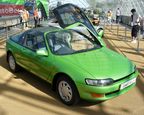Year of Toyota Sera
Toyota Sera photos, specs - Car Pictures & Images
 The Toyota Sera (model designation EXY10) is a two door, four seat (2+2) coupe built by Toyota from 1990 to 1996. Although produced solely for the Japanese market, it raised interest overseas and has since been imported by car enthusiasts into several countries including Australia, Bangladesh, Canada, India, Ireland, New Zealand, and the UK. It was initially unveiled in 1988 as the Toyota AXV-II concept car in almost production-ready form. The name comes from the French word meaning "will be", indicative of both the overall futuristic design and also the closeness of the concept car to the final production version. The Sera is most notable for its butterfly doors which tilt up and forward when opened, and the canopy constructed largely of glass panels. |
Used Toyota Sera
As it was released with only one engine and body type there is technically only one model of the Toyota Sera EXY10. However major option choices such as transmission, brakes and sound-system meant that there were a number of different factory packages. Furthermore, Toyota itself produced three versions (known as 'Phases') over its production life with specific characteristics (such as interior trim), although variations between the three are largely cosmetic. A total of 15,852 units were built and registered in Japan, however with niche market car importing occurring in the early 1990s it is possible that some vehicles were constructed and exported directly from Japan without first being registered there. As such it is difficult to know exactly how many Seras were produced, although it is certainly less than 16,000 and they are now becoming rare collectibles. MechanicalAll Seras came with the 1.5L (1496cc) inline 4 5E-FHE unleaded petrol engine, the largest capacity version of Toyota's E series of engines included in other Toyota vehicles such as the Paseo and the Starlet. This was installed in a front-mount, front wheel drive transverse configuration with electronic fuel injection. All versions came with power assisted rack and pinion steering and either a 4 speed automatic or 5 speed manual transmission. The brakes were vented discs at the front and drums at the rear, unless fitted with the optional Anti-Lock Braking system which had vented discs all round. Mechanically the car is related to both the Toyota Paseo and the Toyota Starlet, sharing similar floorpans, suspension, steering and brakes amongst other items. As such many consumable parts such as brakepads and springs are interchangeable and still readily available from parts suppliers. BodyThe Toyota Sera is of a steel monocoque construction with a low and rounded body shape. It is a two door plus hatch (sometimes referred to as three door or hatchback) coupe. The Sera's most distinctive feature is its butterfly doors, which are hinged at the top and bottom of the A pillar and open forward and up in a manner similar to the McLaren F1 and Saleen S7. The weight of the door is predominantly supported by a thick gas strut, and counter-balanced by a smaller secondary strut inside the door to help take into account changes in temperature. With age these struts can lose pressure causing the doors to sag or fail to stay open, however the issue can be resolved by re-gassing or replacing the strut. Unlike the conventional side-opening doors on most cars, the Sera door can be opened fully in a fairly confined space, requiring only 43 cm of lateral clearance. » Read More About Toyota Sera |










